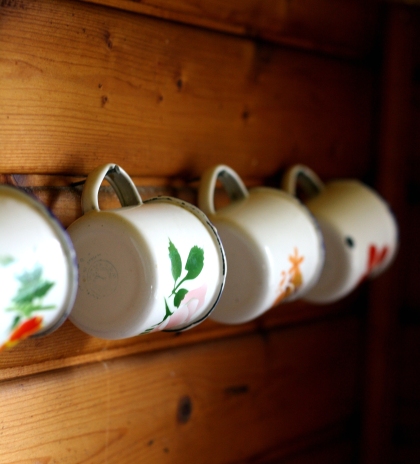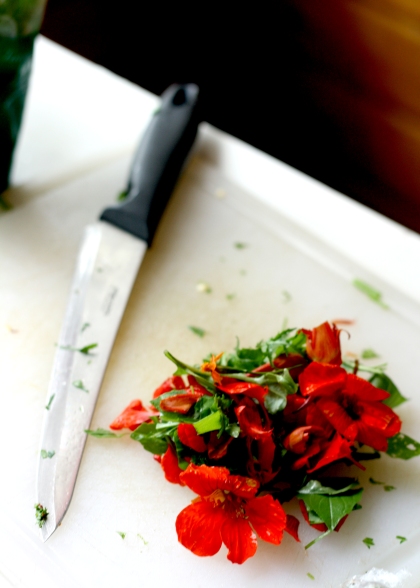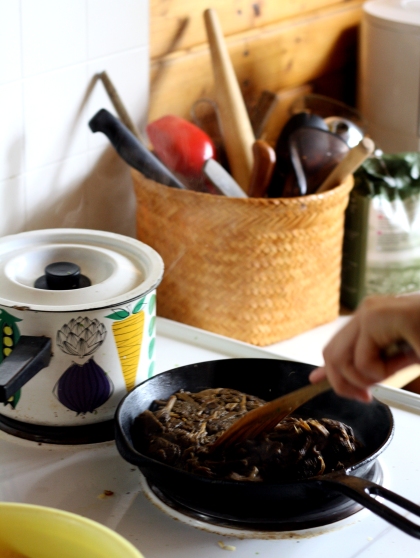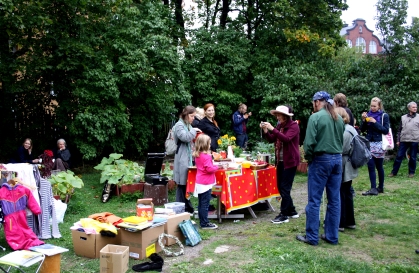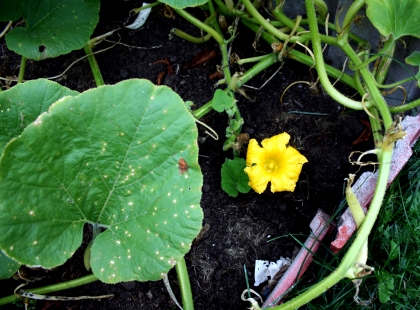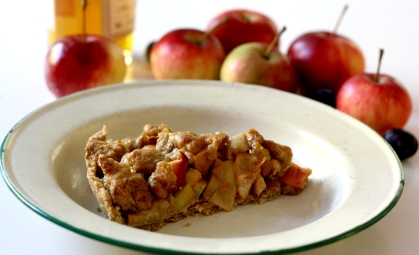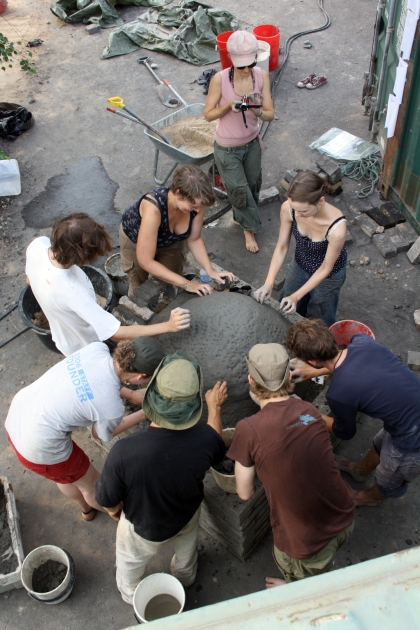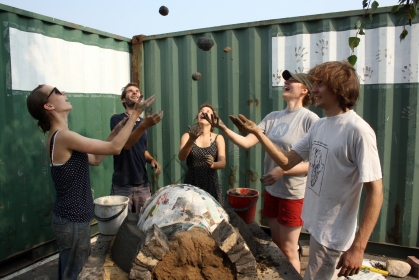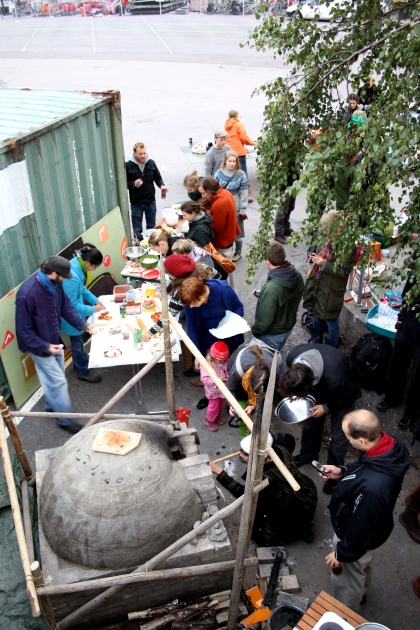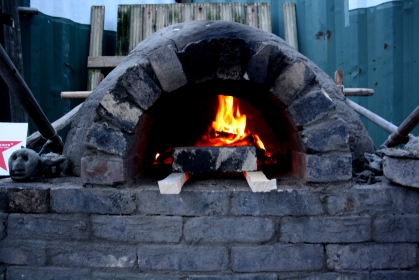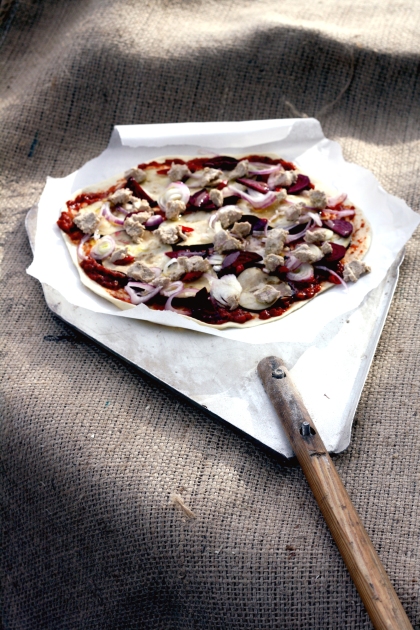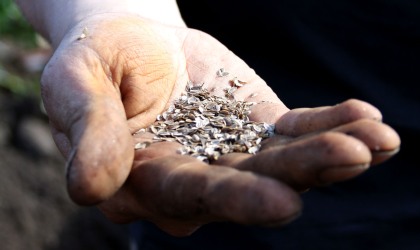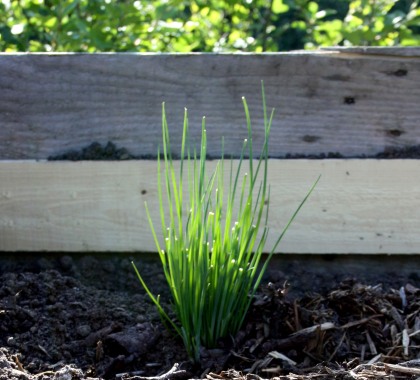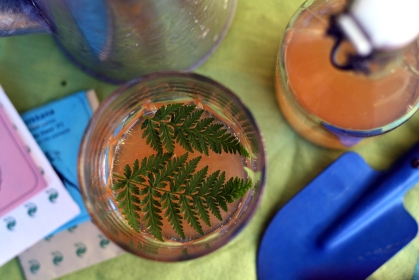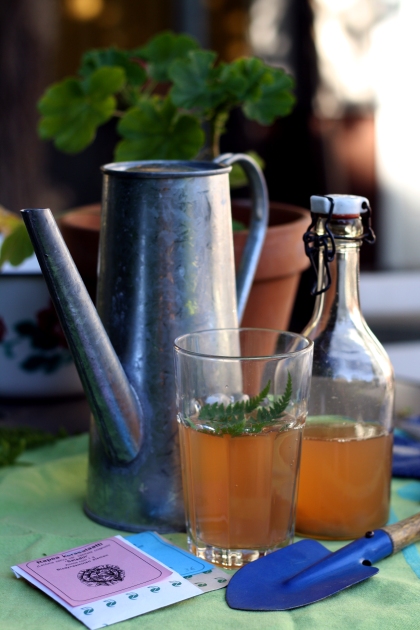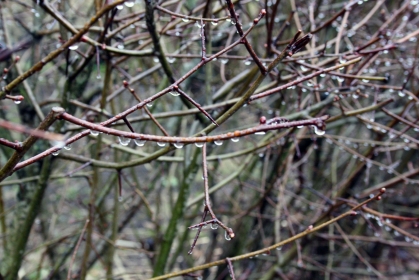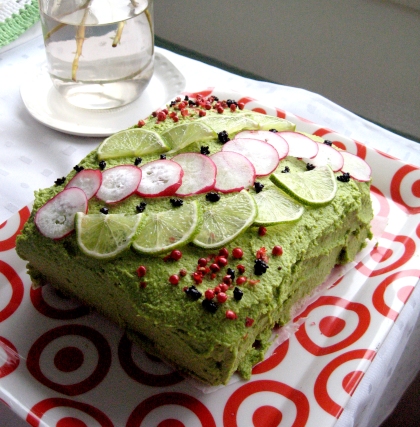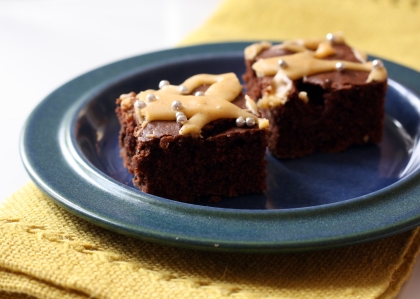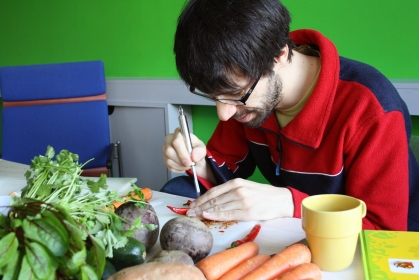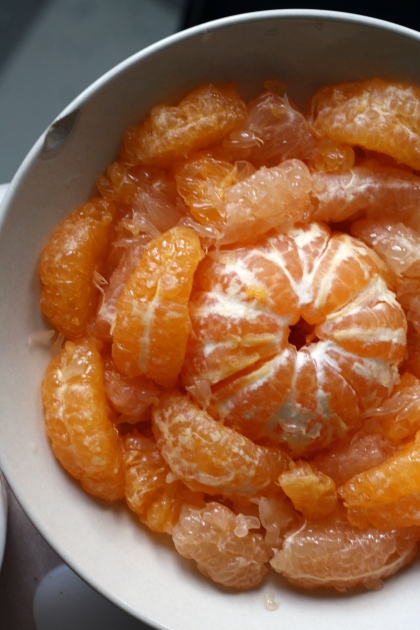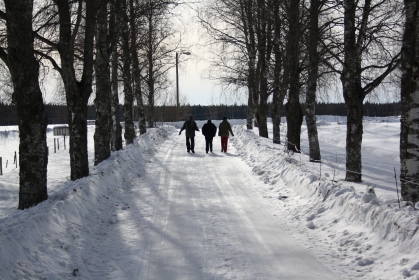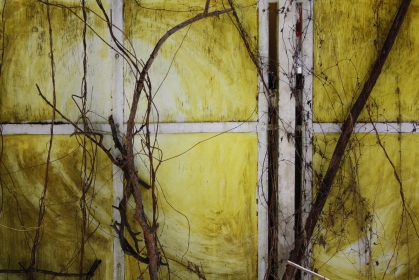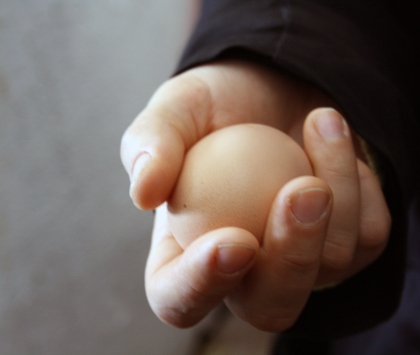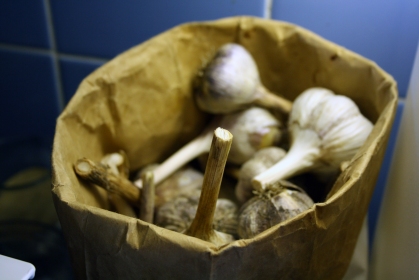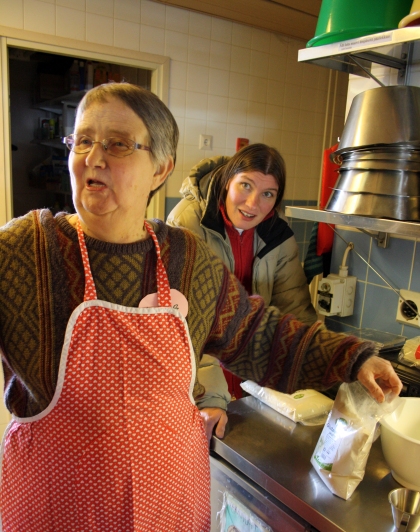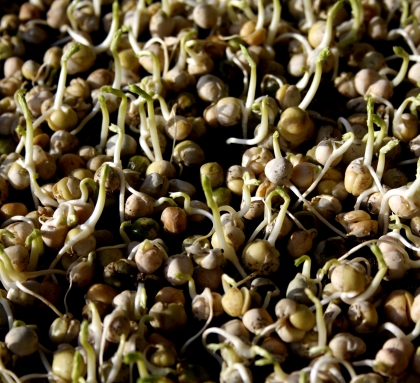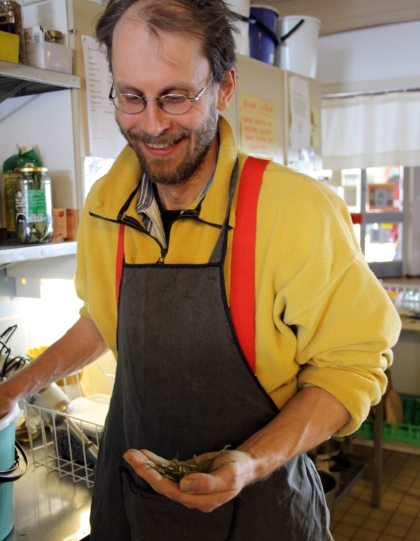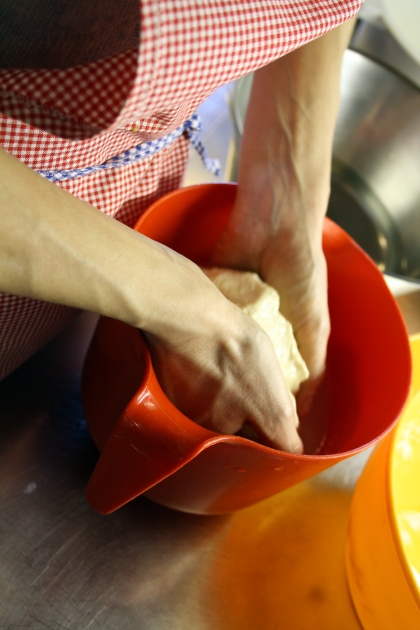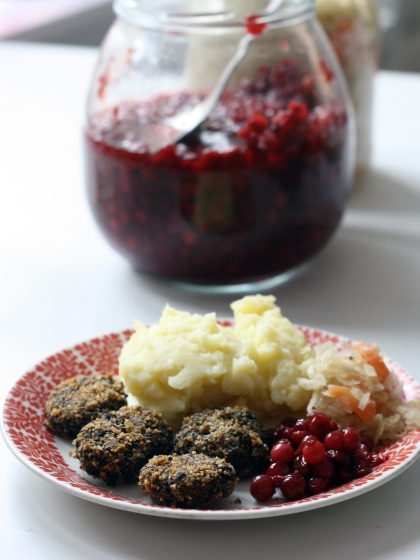A summer cottage is an essential part of the Finnish mindscape: Finland was urbanized only quite recently, and most of us still feel that our roots are in the country. The Finnish dream contains a summer cottage: a simple dwelling in the woods, by a lake, faraway from the neighbours. On a summer cottage the Finn relaxes, wears some ugly clothing dating back 20 years, enjoys the cool waters of the lake and a hot sauna, rowing trips, inefficient fishing and a barbecue. In the previous days it was also common that the amenities at the summer cottage were quite basic: no running water, just a well, and no electricity even. At the summer cottage, the past is somehow close: old things crowd the cupboards and family secrets crowd the air.
I remember my childhood summers, long and hot, at our summer cottage. My parents, who were quite uncapable of relaxing even on a holiday, worked on their projects, my dad building something or other and my mom expanding her huge kitchen garden. I played on shores of the muddy lake and in the forests with my imaginary playmates, woodland fairies and mermaids, when I didn’t have to help my mom weeding in the garden or picking berries from thorny bushes. My enthusiasm for gardening these days continues to surprise me when I remember how much I hated garden – work as a child!
Now it is the time all Finns who have the opportunity will escape cities to the country, for Midsummer’s Eve – parties and magic! Happy Midsummer to you all!
Sangria
Sangria may be the ultimate summertime drink. Thanks for the recipe to the playwright Pipsa Lonka!
4 cl gin
2 cl flagg punsch (swedish alcoholic drink)
1 tbsp sugar
2 bottles of light red wine
the juice of one orange
the juice of one lemon
1 l sprite etc. soda
1 dl beer
Plenty of ice cubes made of orange juice
One lemon, one orange and one lime sliced
Strawberries, watermelon, any fruit you have at hand.
First mix gin, punsch, sugar, red wine, lemon juice and orange juice. Let the taste develop for a few hours. Just before serving add the sprite, beer, ice cubes and the chopped fruit.
Filed under: autumn seasonal food, Baking, urban gardening | Tags: apple, calvados, marzipan, pie
I recently heard a quote from somebody (thanks, Tanja!) that in every project 1/4 of the money and energy invested in the project should be used to celebrate together. I think that is so true! In the Finnish culture celebration is easily undervalued: we don’t even have a really good word for it. A celebration can be a party or a carnival, but it can also be any kind of a gathering or ritual that values the work done and the people involved. In a celebration we are together, equal and sharing a mutual satisfaction in our community and what was experienced. A celebration turns inward, toward the center, a party turns outward, showing off. Celebrations create social value and strenghten communities, and make people happy!
A harvest party is of course double important since it also the time to thank the abundance of the earth as well as for human people’s efforts. Being an urban gardener it does sound a bit dodgy to say: thank you Mother Earth. Should I say thank you Sister City instead? But I guess whether rural or urban, it is the same life – force manifesting itself in the beautiful vegetables.
There was a harvest party at the urban garden of Vallila, with grammophone – music, a fleamarket and of course pumpkin soup. A drizzling autumn rain finished the party, but there was just enough time to greet everybody and share the last of the huge marrows and pumpkins. It is wonderful to start gardens on empty lots: the neighbours learn to know each other and a public space becomes meaningful, a hub of interaction between the people of the neighbourhood as well as place to grow local food in a city. Present at the party was also the Editor in Chief of the fanciest foodie magazine in Finland, Glorian ruoka ja viini, since she lives in the neighbourhood. Today, in the new issue of the magazine they nominate “urban gardening” as the Food Phenomenon of the Year, and my organisation and our projects are specially mentioned. I felt as if I’d been awarded an Oscar! Me, doing the Food Phenomenon of the year? Who would have thought? I was very happy that the culinary aspects of urban gardening are now formally recognised!
To honor that, an apple pie recipe:
Apple Pie with Calvados and Almond
Crust:
3 dl whole wheat flour
125 g vegetable margarine
1tbsp oat milk
1 tbsp sugar
a pinch of salt
On top:
4 dl sliced apple
2 tbsp calvados
cinnamon
Top crust:
100 g marzipan
100 g vegetable margarine
1 tbsp muscovado sugar
1 dl wheat flour
Mix the ingredients for the crust quickly in a bowl. Set the crust in the fridge. Slice the apples, and grate the marzipan, and mix it with the other ingredients of the top crust. Cover a baking pan with a diameter of 24 cm with the rolled out crust, and place it in the freezer for 10 minutes. Then bake the crust in a 200°C oven for 10 minutes.
Sprinkle the crust with the apple slices, calvados and cinnamon. Crumble the top crust on top of that. Lower the temperature down to 175ºC and bake the pie in the oven 35 – 40 minutes.
Filed under: Baking | Tags: cob oven, sourdough, vegan pizza, walnut, zucchini
You know, how sometimes magic touches your life? When impossible things turn into reality, without much effort or try. This is what happened to me and a bunch of other people, when we started to build the cob oven Archie. There are hundreds and thousands of cob ovens in the world, but so far there was none in Finland. By coincidence, or fate, I met Katharina, who wanted to have some good bread, and after that, as they say, the rest is history.
A cob oven is a simple, traditional oven, made of mixed sand and clay. Everyone told us that it is impossible to build an oven like this, at the end of August, in Finland. “It won’t dry, it’s too late in the summer”, “You won’t get a permission”, “there is no such clay for sale”, but somehow, via open platforms, like the Public School Helsinki website, facebook and the generosity of Hub Helsinki, we found enthusiastic people, clay, space, cars, trailers, bricks and a place for our oven, in the area of construcion area of a new urban district. We scavenged the materials, build it, and named it Archie after the nice arch Daniel made. And the weather was perfect, and we, individual people, became the Tribe of Clay, the Tribe of Archie. Oh happiness, to build something together, to celebrate together, to share food and laughter.
Last weekend, we baked perhaps 70 pizzas at the Dodo urban harvest party and Katharina organized an art workshop with baking rieska, Finnish flat bread (check out her blog on food related art happenings in Helsinki!). The oven works like a dream, and somehow, after the magical building process a good flow continued in my life. All kinds of gifts were shovered on me, from jars of mint on my windowsill to phonecalls from just the right people, and even some much more substantial things… but isn’t it strange, how sometimes it is so difficult to accept these gifts from the universe? You just don’t believe you could be worth the abundance and good luck fate is throwing on your way, and so you just block the flow with your own unwillingness to accept and let go with it.
But anyhow, now in my life there is a lovely group of new friends and the most wonderful wood oven at just a 15 minute bikeride away! Urban gardens and an oven, what next? Be ware, Helsinki, we are going to change you for good!
Woodfired Cob Oven Pizza with Beetroot and Walnut Pesto
Start by building an oven… well, I’m kidding but it really isn’t so difficult! Very good, detailed instructions can be found at the Clay Oven. And if you want to use the oven Archie in Helsinki, you can find more information on our blog Stadin uuni on how to make a reservation. We hope that the oven will birth a whole new culture of urban social baking events, so feel free to contact us!
My vegan pizza was made using a sourdough starter and some nice vegetables that were a product of urban farming. Here in Finland pizzas are always suffocated with cheese, but in Italy where they originate, there is a lot of delicious pizza baked without cheese.
Pizza – sourdough (makes 3 – 4 pizzas)
1/2 dl sourdough starter
2 dl lukewarm water
enough flour to make a porridge – like mix
Mix the ingredients in a bowl and cover with a cloth. Wait until the following day. The flour you are using should have at least 12% protein in it. I used extra fine wheat flour, but also other types of protein – rich wheat flours could be used.
The next day
5 – 6 dl flour
1/2 tsp salt
2 tsp olive oil
Mix the flour, salt and olive oil into the dough, and knead it for a few minutes. Let the dough rise for an hour or two. If possible, at least once this time fold down the dough and let it rise again since that enhances the rising.
Tomato sauce
1 can of crushed tomatoes
1 tbsp tomato paste
1 tbsp muscovado sugar
2 tsp salt
1 tsp olive oil
dried basil, thyme and oregano a tablespoon each
1 clove garlic
1 mild red chili bean
Mix the ingredients in small cooking pot, and let simmer on low heat at least 15 minutes.
Pizza Toppings:
Walnut pesto (50 g lightly toasted walnuts, 1 tbsp of olive oil and water each, salt to taste, all mixed with a hand held blender)
Thinly sliced eggplant (cut beforehand and salted in order to get rid of bitter liquid)
Thinly sliced beetroot
Thinly sliced red onion
Finely chopped red mild chilli bean
Olive oil
Fleur de Sel
For topping: fresh basil/ arugula
Fire your oven until very hot (300 ºC about), remove the coals to the sides to make room for your pizza. You can either use a lot of flour or baking parchment to be able to move the pizza from the pizza peel. Roll out the pizza dough, very thinly, and spread the tomato paste and other fillings on it. Insert the pizza in the oven, and bake for a few minutes until it looks done, and the edges are puffed. Decorate the pizza with fresh arugula or basil. Devour while still hot!
As a mature feminist I should probably think that princesses are a remnant of patriarchal society that should by now be thrown away with other rubbish. Well, in a way I do. But still, when there is an actual, real, royal – blooded, beautiful princess getting married in the neighbouring country, I must admit that something in me is evoked. We Finnish people are so sensible and not at all prone to unnecessary, costly silliness like a royal family, so I guess we can be a little bit delighted for what happens next door, in Sweden?
Recently, I have been very brave and done lots of things that have felt immensely difficult. So I decided to reward myself and bake a cake! And spend a couple of days only doing only silly things with my girlfriends. So we watched Princess Victoria’s and Daniel’s wedding and drank strawberry – sparkling wine, eating a cake that in Finland is called a princess cake. Partly because in honor of the actual princess and partly to remind myself of some princess – like virtues. A Real Princess, the mythical, archetypal creature of fairytales, is never angry, never mean to other people, and always in possession of her power and her beauty. And there is always the happy ever – after to her story. In real life, the princesses get eating disorders and have unfaithful boyfriends, and I guess the only true happy end awaiting us all is the peaceful grave. But still, there is always enough reason to spent a day dreaming princess dreams, with a piece of cake, and congratulate yourself for a work well done.
Vegan Princess Cake
A princess cake is usually a quite an ordinary sponge cake, filled with vanilla custard, raspberries and covered with a layer of green marzipan. Mine was a little different, because I used strawberries and pink marzipan for the ultimate princess – effect. The custard or pudding I made of oat milk and starch.
The Cake
4,5 dl all – purpose flour
2 tsp baking powder
0,5 tsp baking soda
a good dash of vanilla
2 dl brown sugar
1 tbsp apple vinegar
0,5 dl canola oil
4 lingonberry cider
Mix first the dry ingredients and then add the vinegar, oil and the cider. Mix quickly with a spoon, until the batter is fairly even, and pour into a round cake tin, 24 cm in diameter. Bake in 175 °C 30 – 40 minutes, until a toothpick inserted in the center comes out clean. Lingonberry cider gives the cake a lovely reddish hue, but you can as well use another kind of cider. Let the cake cool down before filling it. Meanwhile, make the custard:
The Custard
3,5 + 0,5 dl oat milk
a good dash of vanilla powder
1 tsp sugar
2 tbsp potato starch
First, mix the vanilla powder and sugar with 3,5 dl of oat milk, and bring the it to the boil in a small cooking pot. Mix the potato starch with the remaining 0,5 dl oat milk, remove the pot from the heat and pour in the starch – liquid, carefully whisking. Then bring the oat milk to boil again, without mixing. Don’t cook, but remove the pot from the heat right when you see the first bubble.
Filling and Decorating
2 dl whippable oat cream
150 g pink marzipan
1 dl oat milk for moistening
2 dl strawberries, mashed
Whip up the oat cream, and blend it together with the custard. Cut the cake into to halves, and moisten it with oat milk. Fill the cake with mashed strawberries and half of the custard, and finally cover the whole cake with a layer of remaining custard mixture. Roll the marzipan into a flat round layer, bigger than the cake, with a rolling pin. Using a sheet of baking parchment under the marzipan might help, as well as sprinkling the sheet with powdered sugar. Lift the marzipan – layer carefully on top of the cake, and cut off the extra at the “hem” of the cake. Decorate with real roses and sprinkled powdered sugar.
Filed under: Baking, Cakes | Tags: chocolate, green peas, pesto, sandwich cake, sea buckthorn, sun dried tomato
Even more than sunny spring days, I enjoy those overcast days with a slowly drizzling spring rain. Does it mean that I have a plants’ soul?
The Finnish year – cycle is structured between the two inactive seasons: the winter and the summer. After the long, dark lull of the winter the spring is a rushed burst of energy: in just a few short weeks the nature is turned from bare potential to a full blooming fertile beauty. Each week you hear a new migrant bird, and the amount of light increases day by day, until the darkness is just a memory, easily forgotten. And then you reach summer, the lovely, lazy season of free time, when nothing much happens, and the greatest newsline is a trout – bitten toe.
For a delicate mind spring can be depressing too, since it sets you face to face with the inevitability of all life: whether you catch the big rolling wheel or not, life will go on, with or without you. Spring is usually rich with deadlines, whether at work or full moons for planting things or enjoying the newly reborn nature. The elder will bloom only a day (did you collect the flowers for a juice? ) and the sprouting wild vegetables will turn bitter in couple of weeks (did you make the pesto?). The spring rolls on, and meanwhile you might struggle with a pollen allergy, unfixed bike and the continuous daylight that doesn’t let you sleep, and as the only thought have the idea of the summer holiday somewhere ahead, if you just manage a little bit longer.
Green Sandwich Cake
Springtime is also time of festivities of all sorts, and the Finnish traditional delicacy for a graduation party or other family festivity is a sandwich cake, which is a savoury cake made of a bread loaf (!). My friends insisted on having one at their house – warming party.
What happened was that on the Eve of First of May, which is a night of great many parties in Finland, I emptied my handbag on my doorstep at 3 am and figured that I’d left my keys inside. The cake was supposed to be ready the following day. I ended up spending the night elsewhere, and in the morning found a big kitchen full of jamming, singing and guitar – playing people. And even if the brunch was rather meagre, only one third of a shop bought pound cake, the music was such soul food that I just couldn’t leave the soaring voices and harmonies of the morning of First of May. So in the end the sandwich cake was assembled of things that I found in my cupboard, in a haste. But everyone loved it.
Ingredients:
a loaf of bread, and 5 dl oat milk.
Green Pea Paste – for Icing
250 frozen green peas
1 tl grated horse radish
1 dl canola oil
1,5 dl sunflower seeds
3 tbsp lime juice
salt to taste
I threw the peas quickly to boiling water, strained them and blended everything with a hand held blender.
Pesto Rosso – for Filling
2 dl sun dried tomatoes in oil + the oil
1/2 dl sunflower seeds
1 garlic clove
I blended everything to a paste with a blender.
Lemongrass Mayo Paste – for Filling
1/2 dl lemongrass mayo (Plamil)
1/2 dl vegetable margarine
1 apple
salt to taste
I blended everything to a paste.
For a sandwich cake you need a tin – baked loaf of bread, and it should not be fresh, but dried out a bit. Cut off all the crusts, and slice the bread diagonally into three layers. My loaf was too long to fit in my cake container, so a cut into half and made a square – shaped cake by putting the halves next to each other. Then I filled the cake, and moistened it using oat milk. I used about 5 dl of oat milk for moistening. It is good to start a day before, and let the cake stay in the fridge overnight. The following day put on the icing and the other decorations. My “icing” was a paste made of peas, and it turned out very well, sticky and not runny at all (must be the proteins in peas).
I decorated the cake with lime slices, very thin slices of radish, red peppercorns and pinches of black vegan caviar.
Sea – Buckthorn Chocolate Bites
This is another one of those let’s just bake something with whatever ingredients there happen to be at hand – kind of thing. The sea – buckthorns grow quite close to where I’m living and were a result of urban foraging last autumn (me and my Australian guest, in almost total darkness). Sea – buckthorn is extremely rich in vitamin C, and a very challenging berry to pick because of the nasty thorns in the bushes. It is also very, very sauer, almost bitter in taste, and does need a bit of sugar to be truly delicious.
4,5 dl flour
2 tsp baking powder
1 tsp baking soda
1 tl bourbon vanilla powder
1 dl cocoa powder
2 dl sugar
100 g dark chocolate, chopped
0,5 dl oil
4 dl oat milk
1 tl vinegar
Mix the dry ingredients and then add the oat milk, oil and vinegar. Pour the batter into a greased and floured oven pan, size 20 cm x 15 cm. Bake in 200 °C about 4o minutes, until a toothpick inserted into the center comes out clean. Let cool, and decorate with
Sea Buckthorn Icing
2 dl powdered sugar
1 dl frozen, thawed sea – buckthorn berries
Grind the berries through a sieve, to get rid of the seeds, and then mix the remaining paste with powdered sugar. Sprinkle on top of the chocolate cake. I also used some silver cake pearls for a finishing touch.
Aren’t vegetables just the most beautiful things? Did you ever think of using them as a medium for art? 
Of course, it is a very thin line in between Art and something your mother would have scolded you for. We discoursed that thin line between playing with your food and artistic self – expression at the Public School Helsinki, at a food sculpture workshop. The Public School is an amazing skill sharing project that exists in several other cities too. Maybe you’d like to start one where you live?
I piled everything on the table, and we got at it, with our fingers, knives, zesters, cheese slicers and peelers, cutting, molding and slicing.
The sculptures were beautiful.
Finally, we chopped them up and made a big pot of curry, and ate it together. One of the sculptures we simply put in the oven whole, drizzled with some olive oil, salt and pepper. It became quite crispy and delicious.
It was so much fun… Soon, I’ll organise another workshop, with more food and people!
Filed under: Cooking, winter seasonal food | Tags: dessert, funnel chantarelle, hemp, lingonberry, rye, vegan croquettes
Permaculture, in case you never heard the word before, is the art of designing sustainable habitats by imitating natural ecosystems. I was invited to one permaculturalist – gathering in one ecovillage, and then to another ecological community, to teach permaculture on an Ecovillage Design Education – course. Permaculture is a design system that searches for solutions for ecovillages, organic gardening, sustainable agriculture and social change, or anything else that gears towards a more sustainable life. The first ecovillage I visited was young and punky, and the second one a bit older and more established, but anyway it was interesting for me to do this little road trip to my past.
I was picked up from the trainstation by the old Hiace full of backbacks and hippies, and we hit the dark snowy roads towards Central Finland. The three – year – old chattered away on the front seat, I got the see mobile phone photos from a demonstration in England, and we stoppes and peed in a row on the roadside snow (yes, alternative people do that). Late at night, we arrived at the ecovillage, and got greeted with a plate of broad bean soup and a house full of friendly people, children and dogs. It was the eve of Spring Equinox, and everybody in the house was bursting with energy for outdoor life, after a winter spent indoors.
In the second ecovillage I get to teach on a Ecovillage Design Education – course, so we talk about permaculture principles: 1. Follow nature’s patterns. 2. If you are not having fun, you are not doing it right! 3. Imagination is the only limit to the system’s yield 4. Start small, observe and interact! 5. Design from pattern to details, et cetera. We also think about closed loops and sustainability. What kind of system is sustainable, and why?
After permaculture we discuss local food and the eco – footprint of different foodstuffs. Which is better, ordinary tea or organic coffee? Which has a heavier footprint, organic local cheese or a canned coconut milk? Sometimes we teachers even don’t know the answers, but after the class we do a hands – on approach on local food, and cook seitan, hemp sauce, nettle pancakes with lingonberries and oven cooked whole oats for the group, and as dessert some whipped rye with berries. It’s chaotic, and fun, and the food is delicious.
In the evenings the communal kitchen is lit and the people clean away the leftovers of dinner. They laugh softly, talk about small things: ” We should put more dish rags on the shopping list!”, somebody leans on the counter, sips a cup of herbal tea. Somehow, I’m a little jealous of that easy companionship, the fellowship of the kitchen counter, even if I once lived here and doomed it not to be for me.
The course is very interesting, and I’m becoming very fond of the morning heart sharing circles: I simple excercise in which we four randomly chosen, very different people talk about our lives and the expectations we have for it. It’s very powerful, and in the end there is no way but to like the people in my group very much. The last morning, we do the hippie classic, a group hug, and it feels like the most natural thing to do in the world.We have woven a surprising little web of connection, in this time and space.
Ecovillage Food
Most likely, if you are a Finnish person trying to eat locally grown food, you are at this time of the year pretty stuffed with root vegetables, delicious that they are, after eating them for months. Now the first green wild veggies are sprouting in the nature, but you can still use some imaginative recipes that don’t require too many fresh ingredients.
Hemp and Funnel Chanterelle Croquettes
These are delicious vegan croquettes, though they ask for a fair amount of mushrooms. But last autumn was really good for funnel chantarelles, so there is plenty to eat. These patties stay together very well, thanks to the proteins of hemp.
This recipe I learned from my friend Aino, thank you!
2, 5 dl dried funnel chantarelles, soaked
1 onion
2 dl hemp meal
2 dl bread crumbs + 1/2 dl for breading
1 – 2 dl oat milk
1 tsp salt
1 tsp dried paprika
1 tsp dried basil
oil for frying
Soak the funnel chantarelles in water for 10 minutes. Chop the onion finely, and the mushrooms too. Sauté both on a pan, in oil, for a few minutes, then mix together with the hemp meal, bread crumbs and spices. Add oat milk, enough to make a nice dense paste that can easily be made into patties. Let the paste sit for a few minutes, and then make small balls or patties. Roll them in bread crumbs, and fry both sides in oil.
Hemp meal can be easily ground using a food processor.
Serve with mashed potatoes, lingonberry mush and sauerkraut.
Whipped Rye with Berries
This is a surprising dessert! The rye flour will turn light and fluffy, if you have the patience to whip it for several minutes. You can make it with lingonberries, blackcurrants or any other slightly tangy berries
1,5 dl extra fine rye flour
2,5 dl boiling water
0,5 dl sugar
1 tsp vanilla
4 dl berries (if frozen, thawed)
Blend all the ingredients, and whisk with an electric whisk for a few minutes, until fluffy.



